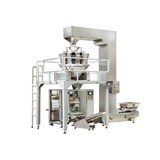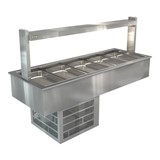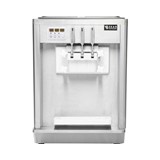Refrigerated display cabinets play a crucial role in preserving the freshness and appeal of perishable products. Whether you own a grocery store, a bakery, or a convenience store, maintaining and caring for your refrigerated display cabinets is vital for their longevity and optimal performance. In this article, we will explore the essential tips and practices for proper maintenance, ensuring your cabinets function efficiently and help you showcase your products effectively.
1. Introduction
Refrigerated display cabinets are designed to keep food products at a controlled temperature while providing an attractive display for customers. These cabinets are commonly used in supermarkets, delis, and other food retail establishments. Proper maintenance and care are necessary to ensure the longevity of these cabinets and to prevent any issues that may affect the quality of stored products.
2. Why Proper Maintenance is Crucial
Regular maintenance of refrigerated display cabinets offers several benefits. Firstly, it helps in extending the lifespan of the cabinets, reducing the need for frequent repairs or replacements. Secondly, it ensures the cabinets operate at their optimum efficiency, maintaining consistent temperatures and preserving the quality of perishable items. Additionally, proper maintenance reduces energy consumption, leading to cost savings in the long run.
3. Cleaning and Sanitization
Regular cleaning and sanitization are fundamental to maintaining the hygiene and functionality of refrigerated display cabinets. Follow these tips:
- Wipe down surfaces: Clean the interior and exterior surfaces of the cabinet using a mild detergent and a soft cloth. Pay close attention to door seals, shelves, and glass surfaces.
- Remove and clean shelves: Take out the shelves and wash them with warm soapy water. Ensure they are thoroughly dry before placing them back in the cabinet.
- Sanitize with a food-safe solution: Use a food-safe sanitizing solution to disinfect the interior surfaces, eliminating any bacteria or odors.
- Defrost and deep clean: Periodically defrost the cabinet and perform a deep cleaning to remove any ice buildup or debris from the drainage system.
Remember, cleanliness not only enhances the presentation of your products but also prevents the growth of harmful bacteria and ensures food safety.
4. Temperature Control and Calibration
Maintaining the appropriate temperature is crucial for refrigerated display cabinets to preserve the quality and safety of stored items. Follow these guidelines:
- Monitor temperature regularly: Use a thermometer to monitor the temperature inside the cabinet daily. Ensure it remains within the recommended range for the specific products you are storing.
- Calibrate the thermostat: If you notice temperature inconsistencies, consider calibrating the thermostat or consult a professional technician to adjust it accurately.
- Avoid overloading: Do not overcrowd the cabinet with products as it can obstruct proper airflow and affect the cooling efficiency. Allow adequate space for air circulation.
By maintaining the correct temperature and regularly checking for fluctuations, you can ensure the freshness and safety of your products.
5. Organizing and Arranging Products
Efficient organization and arrangement of products within the refrigerated display cabinet can enhance visibility and accessibility. Consider these tips:
- Rotate products: Implement the "first in, first out" (FIFO) principle to ensure older products are used or sold first, reducing the chances of spoilage.
- Categorize and label: Group similar products together and label them appropriately for easier navigation and identification.
- Optimize shelf space: Utilize adjustable shelves to accommodate products of various sizes, maximizing the available space and preventing overcrowding.
A well-organized display not only improves the overall aesthetic but also facilitates better inventory management and reduces the likelihood of product wastage.
6. Inspecting and Replacing Components
Regular inspection of the various components of your refrigerated display cabinets is essential to identify any signs of wear or malfunction. Consider the following:
- Check door seals: Inspect the door seals regularly to ensure they are intact and free from cracks. Damaged seals can lead to temperature inconsistencies and energy wastage.
- Inspect lighting: Verify that the cabinet's lighting system is functioning correctly, as adequate lighting enhances product visibility and customer experience.
- Examine fans and motors: Check the fans and motors for any unusual noises or vibrations. If detected, consult a professional technician to address the issue promptly.
- Replace worn-out parts: Replace any worn-out components, such as fans, motors, or temperature sensors, to maintain the cabinet's optimal performance.
By promptly addressing any component issues, you can prevent further damage and prolong the lifespan of your refrigerated display cabinets.
7. Energy Efficiency and Cost Savings
Efficient energy usage not only benefits the environment but also helps reduce operating costs. Consider these energy-saving measures:
- Ensure proper door closure: Make sure the cabinet doors are closed tightly to prevent cold air leakage and minimize energy wastage.
- Regularly defrost: Accumulated ice reduces the efficiency of the cabinet. Defrost it regularly to maintain optimal performance and energy efficiency.
- Avoid excessive opening: Minimize the frequency and duration of opening the cabinet doors to maintain consistent internal temperatures.
- Upgrade to energy-efficient models: If your cabinets are outdated, consider upgrading to newer, energy-efficient models. They offer advanced features and better insulation, leading to significant energy savings.
By implementing energy-saving practices, you can reduce your environmental footprint and lower your utility expenses.
Common troubleshooting techniques for addressing temperature fluctuations or equipment malfunctions
When experiencing temperature fluctuations or equipment malfunctions in refrigerated display cabinets, it's important to troubleshoot the issue promptly to prevent any adverse effects on food safety and quality. Here are some common troubleshooting techniques:
1. Check Power Supply:
- Ensure that the display cabinet is receiving power and that the outlet is functioning correctly.
- Verify that the power cord is securely plugged into the outlet and the cabinet.
2. Temperature Settings:
- Check the temperature settings on the display cabinet's control panel.
- Ensure that the desired temperature is set correctly and hasn't been accidentally changed.
3. Inspect Door Seals:
- Examine the door seals for any signs of damage, wear, or debris.
- Clean the seals with a mild detergent and warm water, ensuring they are free from food particles or residue.
- Replace any damaged or worn-out door seals to ensure a proper seal and prevent air leakage.
4. Monitor Air Circulation:
- Verify that there is adequate space around the display cabinet for proper air circulation.
- Check for obstructions such as debris or packaging materials that may impede airflow.
- Ensure that the vents and air circulation channels are clear from any blockages.
5. Defrosting Issues:
- If your display cabinet has a manual defrost function, check if it's due for defrosting.
- Follow the manufacturer's instructions for defrosting and ensure that the process is carried out correctly.
6. Condenser Coils:
- Inspect the condenser coils for dust, dirt, or debris buildup.
- Clean the coils using a soft brush or vacuum cleaner to remove any obstructions that may hinder heat dissipation.
- Ensure that the coils are clean and free from any blockages.
7. Temperature Sensors:
- Check if the temperature sensors in the display cabinet are functioning properly.
- Consult the manufacturer's guidelines to locate the sensors and ensure they are clean and not damaged.
- If a faulty sensor is suspected, contact a professional technician to replace or recalibrate it.
8. Consult a Professional:
- If the issue persists or if you are unsure about the cause of the problem, it's advisable to contact a professional technician.
- They will have the expertise and specialized tools to diagnose and resolve more complex equipment malfunctions.
In conclusion, proper maintenance and care for refrigerated display cabinets are crucial for their longevity and optimal performance. Regular cleaning, sanitization, and deep cleaning help maintain hygiene and prevent bacterial growth. Monitoring and calibrating temperature settings ensure the preservation of product quality and safety. Organizing products effectively improves visibility and reduces waste. Regular inspection and replacement of components prevent further damage and extend the cabinets' lifespan. Implementing energy-saving measures reduces operating costs and environmental impact. By following these practices, businesses can ensure that their refrigerated display cabinets function efficiently, preserve product freshness, and provide an appealing display for customers.




-160x160-state_article-rel-cat.png)









-160x160-state_article-rel-cat.png)








-160x160-state_article-rel-cat.png)




